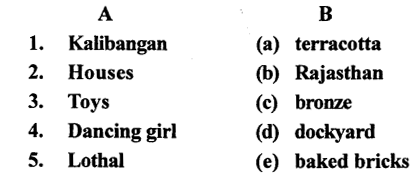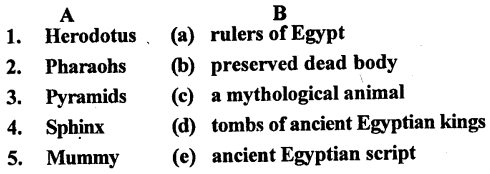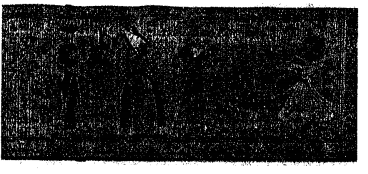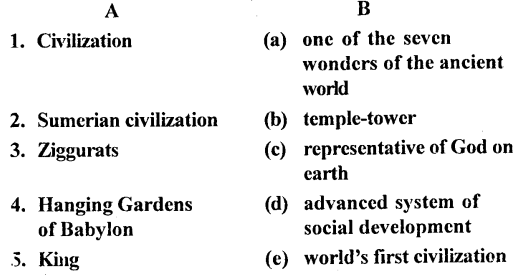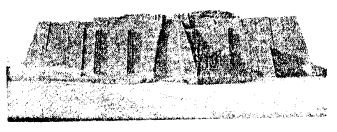The Trail History and Civics for Class 6 ICSE Solutions – The Chinese Civilization
ICSE SolutionsSelina ICSE SolutionsML Aggarwal Solutions
The Trail History and Civics for Class 6 ICSE Answers
Trail HistoryCivicsHistory & Civics Geography Biology Chemistry Physics Maths
Keywords
- Shang dynasty: It was the first known dynasty in China. Ancestor worship is to pray to the dead people of the family. The Chinese believed that human beings become powerful souls after death.
- Oracles: They were priests or holy people who were in close touch with the gods.
- Confucianism was the religious movement named after its founder, Confucius. It taught a practical code of moral conduct and became the state religion of China. Seri-culture It is the breeding of silkworms for the production of silk.
- Mulberry tree: It is a tree with broad, dark, green leaves and edible berries. Silkworms eat the leaves of the white mulberry and the trees are used for rearing silkworms to produce silk.
- Porcelain: It is a hard, white, shiny substance made by baking clay and used for making delicate pottery.
- Great Wall of China: It was built by Emperor Shi Huangdi to protect the country from the frequent attacks of the barbarians.
- Pagodas: are stupa-type temples that were an important feature of the Chinese architecture.
EXERCISES
A. Fill in the blanks.
- The great rivers of China are Huang Ho and Yangtze Kiang
- Emperor Shi Huangdi began the task of joining the independent walls of the Great Wall of China to protect China from the frequent attacks of invaders.
- The Chinese were the first to make silk cloth.
- The chief exports of China were silk, chinaware, tea and paper.
- Confucianism became the state religion of China.
- The Chinese wrote on silk or bamboo slips and later on paper.
- In the 1 st century ce the Chinese made paper from bark of old trees, old rags and fishing nets.
B. Match the following

Answer:
![]()

C.Choose the correct answer:
1. China is bordered by the Himalayas/Pacific Ocean/ deserts in the east.
Ans. China is bordered by the Pacific Ocean in the east.
2. The chief occupation of the Chinese was agriculture/ woodwork/sericulture.
Ans. The chief occupation of the Chines was agriculture.
3. People in China made terracotta/porcelain/bamboo
Ans. People in China made porcelain pottery.
4.The oracles were holy priests/farmers/potters.
Ans. The oracles were holy priests.
5. Taoism/Confucianism/Buddhism became the state religion of China.
Ans. Confucianism became the state religion of China.
D. State whether the following are true or false:
- The first known dynasty of China was the Qin dynasty.
False
Correct: The first known dynasty of China was the Shang dynasty. - The emperor occupied the highest position in Chinese society.
True. - The Chinese developed the art of making porcelain.
True. - The Chinese worshiped the forces of nature.
True. - The Chinese script is a form of picture writing.
True.
- In China, temples were known as stupas.
False.
Correct :In China, temples were known as pagodas.
E. Answer the following questions in one or two words/ sentences:
Question 1.
How was China isolated and protected from the rest of the world?
Answer:
China, this vast country is bordered by the Pacific Ocean in the east, the Himalayas in the south, broad deserts and mountains in the west and Great Wall in the north. Within these boundaries lie the valley of two rivers. In this way China was isolated and protected from the rest of the world.
Question 2.
Name the rivers that gave rise to the ancient Chinese civilization.
Answer:
Huang Ho and Yangtze Kiang are two rivers that gave rise to ancient Chinese civilization.
Question 3.
Describe the social structure of the ancient Chinese civilization.
Answer:
The emperor occupied the highest rung of the social ladder followed by the nobles, the merchants, the craftspeople, the farmers and the slaves. The soldiers occupied a special place in society. They were feared and respected by the people. People lived in groups or clans and respected their ancestors and elders. The family was a close-knit unit.
Question 4.
What were the important occupations of the ancient Chinese?
Answer:
Agriculture, sericulture, domestication of animals, pottery and woodwork are main occupations of the ancient Chinese.
Question 5.
Name the countries with which the Chinese carried on trade?
Answer:
The Chinese carried on trade with Japan, India, Egypt, Mesopotamia , and regions as far as the shores of the Mediterranean Sea.
Question 6.
Which famous Chinese product was the chief item of export in the ancient and medieval ages?
Answer:
Chinese silk was world-famous and the chief item of export during the ancient and medieval ages.
Question 7.
Name the state religion of ancient China.
Answer:
Confucianism was the state religion of ancient China.
Question 8.
Why were the vast majority of people in ancient China illiterate?
Answer:
The Chinese script is a from of picture writing. There were about 40,000 word-pictures. Thus making the script complex and difficult. The Chinese could not understand them. So the vast majority of people in ancient China was illiterate.
F. Answer the following questions briefly:
Question 1.
Why was the Huang He known as the ‘Sorrow of China’?
Answer:
The river Huang Ho was also known as the ‘Sorrow of China’ because it often changed its course after the floods and caused destruction of crops and canals dug for irrigation. People living on the banks of this river were especially affected.
Question 2.
Describe the Great Wall of China. Why was it built?
Answer:
The Great Wall of China was built by Emperor Shi Huangdi.It is one of the most impressive of Chinese architectural accomplishments. It is about 2,400 km long and varies in height from 4.5m to 9m. This wall forms the northern boundary of China. It was built across mountains, deserts and plains. There are 10,000 watch-towers at regular intervals along the wall. It was built to protect the China from the frequent attacks of barbarians.
Question 3.
Describe the town planning in ancient China.
Answer:
City Town Planning—City planning in ancient China began with the urbanization of the Huang He valley in the later part of die Neolithic Age. Urban planning in ancient China followed strict traditional rules of layout and design based on specific religious (e.g. feng shui) and scientific (i.e. astronomical) ideas and principles. The objective was to create favourable and auspicious conditions that would bring balance and harmony between man, government, heaven and earth.

The city of Chengzhou, built during the rule of the Zhou dynasty, represents an ideal city layout. The city was laid out in the form of a square, further subdivided into nine squares. Broad, parallel roads, running north to south, were intercepted at right angles by roads The square running east to west, dividing the city into wards. Palaces, houses, temples, markets etc.
were built within these blocks, each reserved for a specific group of buildings, for e.g., the Inner City with the central palace and government buildings was built in the center (square 5 in the diagram). The Outer City was built around it. The audience hail (square 1), the temples (squares 3 and 7) and the market buildings (square 9) were built within the Inner City. In large cities, rectangular defensive walls with gates were built around the Inner City as well as the Outer City. Some of the larger cities were surrounded by moats.
Question 4.
Briefly discuss the characteristics of the Chinese civilization with reference to
(a) society and
(b) Religion
Answer:
(a)
Society: Chinese lived in groups or clans. They respected their ancestors and elders. The family was a close-knit unit. The emperor occupied the highest rung of the social ladder followed by the nobles, the merchants the crafts- people, the farmers and the slaves. The soldiers occupied a special place and respected by the people.
(b)
Religion: The Chinese worshiped the forces of nature. A widely prevalent practice was ancestor worship. Astrologers and oracles were greatly respected. The oracles or holy priests were supposed to be in touch with the gods.
Question 5.
Give a brief account of the following:
(a) Agriculture
(b) Sericulture.
Answer:
(a) Agriculture: Agriculture was the main occupation of Chinese. They grew rice, wheat, millet, barley and soya bean. At first Chinese cultivated tea for medicinal purposes and later as a popular drink.
(b) Sericulture: Sericulture is the breading of silk warms for the production of silk. The Chinese were the first to make silk cloth and Chinese silk was world-famous and was the chief item of export during the Ancient and Medieval Ages.
Question 6.
Briefly describe:
(a) Chinese pottery
(b) Chinese woodwork.
Answer:
(a)
Chinese pottery: The Chinese developed the art of making exquisite porcelain types of pots and they decorated pots with colourful designs. They were first to make vases, jars, cups, saucers and bowls.
(b)
Chinese woodwork: Chinese used wood on a large scale for the construction of buildings. They made cabinets. The walls of palaces were made of polished wood.
Question 7.
Describe the religious beliefs of people in the ancient Chinese civilization.
Answer:
The Chinese worshiped the forces of nature. A widely prevalent practice was ancestor worship. Astrologers and oracles were greatly respected. The oracles or holy priests were supposed to be in touch with the gods. The emperor of China was regarded as the son of Shangdi, the god of heaven. Later, the Chinese became followers of Confucianism, Taoism and Buddhism.
Question 8.
Discuss the main feature of Confucianism?
Answer:
The principles he taught were basically a practical code of moral conduct. It was more a way of life than a religion. Confucius taught his disciples to appreciate the present world and cultivate the virtues of hard work, modesty, sobriety, gravity and thoughtfulness towards others. He stressed on loyalty and obligations. He attracted a large number of disciples. Later, Confucianism became the state religion of China.
Question 9.
Explain the important features of the Chinese script?
Answer:
The main features of Chinese script were following
- The Chinese script is a form of picture writing. Each picture represents an idea.
- The Chinese language does not have any alphabet.
- There were about 40,000 word-pictures making the script complex and difficult.
Question 10.
Several Chinese inventions have changed the history of the world. Explain any five.
Answer:
Following Chinese inventions have changed the history of the world.
- Chinese first made paper from bark of old trees, old rags and fishing nets.
- The Chinese developed the art of block printing.
- Seismograph was made in China to record earthquakes,
- Other notable inventions were manufacture of gunpowder,
- The mariner’s compass, the water mill, the wheelbarrow, umbrellas and kites.
G Picture study.
This is a picture of the statue of a person who founded a religious movement in ancient China that was basically a practical code of moral conduct.
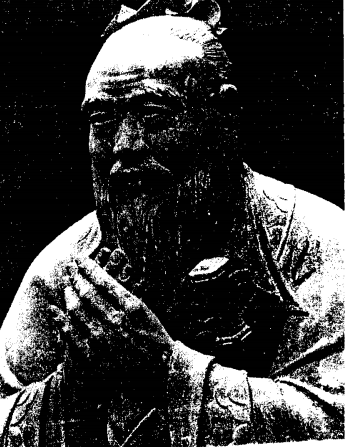
1. Identify the person in the picture.
Ans. The person name is Confucius.
2. Name the religion founded by him.
Ans. He founded Confucianism religion.
3. Mention the important teachings of this religion.
Ans. This religion taught disciples to appreciate the present world and cultivate the virtues of hard word modesty, sobriety, gravity and thoughtfulness towards others. This religion stressed on loyalty and obligations.
4.
Name two other major religions that are followed by the people in this country.
Ans. Taoism and Buddhism are two other major religions that are followed by the people in this country.
OTHER IMPORTANT QUESTIONS
Question 1.
Explain the geographical position of China?
Answer:
China is vast country is boardered by Pacific Ocean in the east, the Himalayas in the south, broad deserts and mountains in the west and Great Wall in the north.
Question 2.
What were the important occupations of the ancient Chinese? Mention two important points for each of the these occupations.
Answer:
Agriculture, sericulture, domestication of animals, pottery and woodwork are main occupations of the ancient Chinese. Sericulture— The second occupation of Chinese was to make silk cloth. Chinese silk was world-famous and was the chief items of export.
Domestication of animals The Chinese domesticated horses, cattle, sheep, pigs, dogs and poultry. They used horses and Horse-drawn carts as a mean of transport.
Question 4.
Give a brief account of the following:
- Chinese society
- Tea cultivation
Answer:
- Chinese society— Chinese lived in groups or clans.
They respected their ancestors and elders. The family was a close-knit unit. The emperor occupied the highest rung of the social ladder followed by the nobles, the merchants the crafts- people, the farmers and the slaves. The soldiers occupied a special place and respected by the people. - Tea cultivation— The Chinese were the first to cultivate tea. At first tea was cultivated for medicinal purposes and later as a popular drink.
